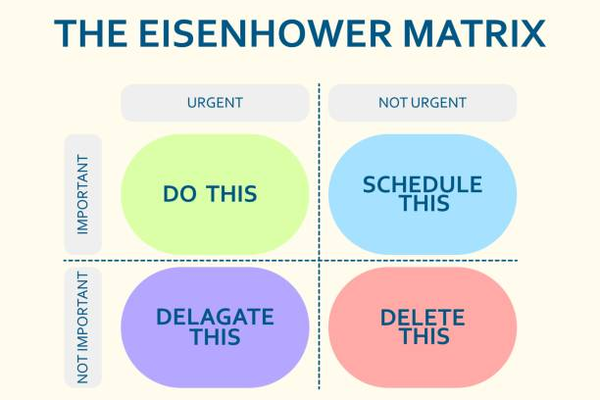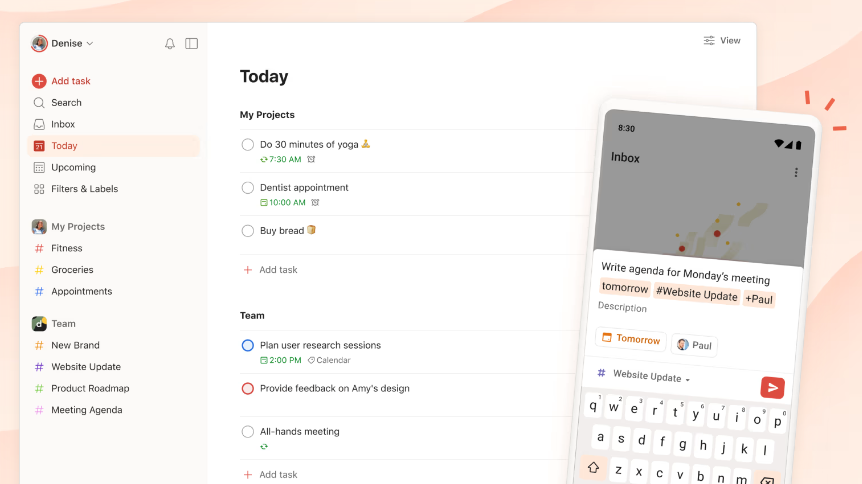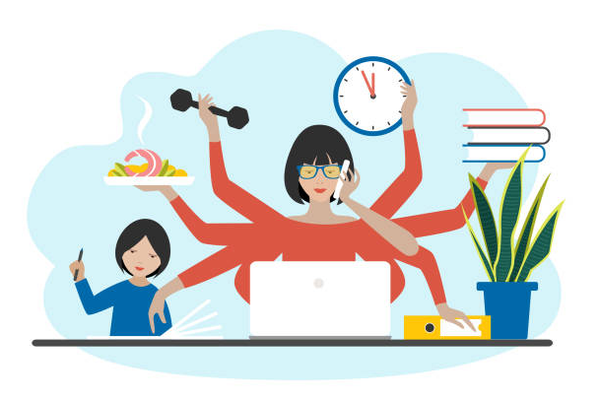Have you ever found yourself wishing there were just a few more hours in the day? It’s a common feeling—almost everyone experiences the frustration of not having enough time to get everything done. In fact, studies show that over 50% of people feel like they don’t have enough time to accomplish all their daily tasks. This sense of time scarcity isn't just a personal struggle; it's a widespread issue that’s become even more pronounced in our fast-paced, technology-driven world.
Time management has always been a crucial skill, but as we step into 2025, it’s more important than ever. The rapid advancement of technology, coupled with the increasingly blurred lines between work and personal life, has made managing time a complex challenge. The rise of remote work, the constant flood of notifications, and the expectation of being always "on" have all added new layers of difficulty to managing our time effectively.
But here’s the good news: mastering time management in 2025 is possible. With the right strategies and tools, you can take control of your time and make it work for you rather than against you. This guide is designed to provide you with a comprehensive roadmap to navigate the complexities of time management in the modern era. Whether you’re juggling multiple projects, working from home, or simply trying to find a better work-life balance, the strategies outlined here will help you make the most of your time in 2025.
 The Evolving Landscape of Time Management
The Evolving Landscape of Time Management
The Impact of Technology on Time Management

In 2025, technology plays a central role in how we manage our time. The rise of artificial intelligence (AI), automation, and a plethora of digital tools has revolutionized our approach to productivity. These advancements have made it easier to streamline tasks, automate mundane activities, and optimize our daily routines.
AI-powered tools like smart assistants can now handle scheduling, email management, and even project prioritization, freeing up valuable time for more meaningful work. For instance, AI can analyze your workload and suggest the best times to tackle specific tasks, taking into account your energy levels and focus patterns throughout the day. Automation tools have also taken over repetitive tasks, such as data entry or social media posting, allowing us to focus on more creative and strategic activities.
However, while these technologies offer significant benefits, they also come with their own set of challenges. One of the primary pros is the ability to do more in less time, increasing overall productivity. Additionally, digital tools provide a level of precision and efficiency that human effort alone might struggle to match.
On the other hand, there are cons to consider. The constant availability of technology can lead to an overwhelming amount of information and tasks, making it difficult to prioritize effectively. There’s also the risk of becoming too dependent on these tools, which can reduce our ability to manage time without them. Moreover, the incessant stream of notifications and the temptation to multitask can fragment our attention, ultimately reducing our productivity.
The Rise of Remote Work and its Challenges
The shift to remote work, which accelerated dramatically in the early 2020s, has fundamentally changed how we approach time management. Working from home offers flexibility and the convenience of eliminating commutes, but it also blurs the boundaries between work and personal life, presenting new challenges in managing time effectively.
One of the most significant challenges of remote work is maintaining boundaries. Without the physical separation between office and home, it can be difficult to "clock out" mentally, leading to longer working hours and an increased risk of burnout. The flexibility of remote work, while beneficial, can also lead to procrastination if not managed properly. When your home is your office, the distractions are endless—from household chores to family members needing attention, or simply the allure of your couch and a good TV show.
To combat these challenges, it’s essential to establish clear boundaries and routines. This might involve setting specific working hours, creating a dedicated workspace, and communicating these boundaries with others in your household. Another effective strategy is the use of time-blocking, where specific hours of the day are dedicated to focused work, and breaks are scheduled to prevent burnout. However, traditional time-blocking must adapt to the unique demands of remote work.
The Importance of Flexibility in 2025
As we navigate the unpredictable nature of modern life, flexibility has become a cornerstone of effective time management. The rigid schedules that once defined productivity are now giving way to more adaptive strategies that can accommodate sudden changes and unexpected events.
One of the most effective strategies for managing time in 2025 is flexible time blocking. Unlike traditional time blocking, which assigns specific tasks to fixed time slots, flexible time blocking allows for adjustments based on real-time needs and priorities. For example, if an urgent task arises, it can be accommodated without disrupting the entire schedule. This approach not only helps in managing work more effectively but also reduces stress by allowing room for the inevitable curveballs that life throws our way.
Incorporating flexibility into your time management strategy also means being open to experimenting with different tools and techniques until you find what works best for you. It’s about understanding that what works today might not work tomorrow, and being prepared to pivot when necessary. By embracing flexibility, you can stay productive even in the face of uncertainty, making it easier to achieve your goals without sacrificing your well-being.
 Practical Time Management Strategies for 2025
Practical Time Management Strategies for 2025
Prioritization Techniques
Effective time management begins with prioritization. Knowing which tasks to focus on can make the difference between a productive day and one filled with busywork. Two classic methods that remain highly relevant in 2025 are the Eisenhower Matrix and the 80/20 Rule.

The Eisenhower Matrix
The Eisenhower Matrix, also known as the Urgent-Important Matrix, is a simple yet powerful tool for distinguishing between urgent and important tasks. This method divides tasks into four quadrants based on their urgency and importance:
- Quadrant 1: Urgent and Important – These tasks require immediate attention and are crucial to achieving your goals. Examples include crises, pressing deadlines, and emergency issues. The key here is to tackle these tasks first.
- Quadrant 2: Not Urgent but Important – Tasks in this quadrant are essential for long-term success but do not require immediate action. Strategic planning, relationship building, and personal development often fall into this category. Prioritize these tasks to avoid them becoming urgent later.
- Quadrant 3: Urgent but Not Important – These tasks demand immediate attention but do not contribute significantly to your goals. Often, they are interruptions or activities that others consider important. Delegate these tasks if possible or address them quickly to move on to more meaningful work.
- Quadrant 4: Not Urgent and Not Important – These are time-wasting activities that do not contribute to your objectives. Examples include excessive social media use or unnecessary meetings. Eliminate or minimize these tasks to free up time for more productive activities.
By categorizing your tasks using the Eisenhower Matrix, you can ensure that you’re focusing on what truly matters, rather than just reacting to what feels urgent in the moment.
The 80/20 Rule (Pareto Principle)
The 80/20 Rule, or Pareto Principle, is another essential prioritization tool. This principle states that 80% of your results come from 20% of your efforts. The challenge is identifying that crucial 20% and focusing your energy there.
To apply the 80/20 Rule, start by analyzing your tasks and identifying which ones contribute the most to your goals. For example, if you're working on a project, determine which specific activities or tasks are driving the most progress. Once identified, allocate more time and resources to these high-impact tasks, and consider reducing or eliminating time spent on low-impact activities.
This principle encourages efficiency and helps ensure that your efforts are aligned with your most important goals, rather than being diluted across less significant tasks.

Leveraging Technology for Better Time Management
In 2025, technology continues to be a game-changer for time management. By leveraging AI-powered tools and time-tracking software, you can streamline your workflow and ensure that your time is spent effectively.
AI-Powered Task Management Tools
AI-powered task management tools have become increasingly sophisticated, offering features that go beyond simple task lists. These tools use machine learning to analyze your work habits, prioritize tasks, and even suggest optimal times for completing specific activities based on your past performance.
Some top AI tools for task management include:
- Todoist with AI Integration: Todoist now offers AI-driven insights that help users prioritize tasks based on deadlines, importance, and their own productivity patterns.
- Trello’s Butler: Trello’s AI-powered automation tool, Butler, allows you to automate repetitive tasks, such as moving cards or assigning due dates, based on your custom rules.
- Notion’s AI Features: Notion’s integrated AI can help you organize and prioritize your notes and tasks, ensuring that you focus on what’s most important.
These tools not only help you stay on top of your tasks but also reduce the mental load of deciding what to do next, freeing up your cognitive resources for more critical work.

Time-Tracking Software
Time-tracking software is essential for understanding how you spend your time and identifying activities that may be wasting it. These apps can provide detailed reports on your daily activities, allowing you to see where your time goes and make informed decisions about how to allocate it more effectively.
Popular time-tracking tools in 2025 include:
- RescueTime: This app runs in the background on your devices, tracking time spent on different apps and websites. It provides insights into your productivity patterns and can even block distracting websites during work hours.
- Toggl Track: Toggl allows you to track time spent on various tasks with a simple start/stop timer. It also offers detailed reports that help you analyze your work habits and optimize your schedule.
- Clockify: Clockify is a versatile time-tracking tool that’s ideal for both individuals and teams. It offers a range of features, from simple time tracking to more advanced analytics, helping you stay on top of your productivity.
By using these tools, you can gain a clear picture of how you spend your time and make adjustments to improve efficiency and focus on high-priority tasks.
The Role of Mindfulness in Time Management
While technology and prioritization are crucial for effective time management, the role of mindfulness cannot be overlooked. In 2025, mindfulness practices have become integral to maintaining focus, reducing stress, and enhancing productivity.
Mindfulness Techniques
Mindfulness involves being fully present in the moment, which can significantly improve your ability to focus and manage your time effectively. Some practical mindfulness techniques include:
- Meditation: Regular meditation practice, even for just a few minutes a day, can help clear your mind, improve concentration, and reduce the mental clutter that leads to procrastination.
- Deep Breathing: Taking a few deep breaths before starting a task can help you center yourself and approach the task with a calm and focused mind.
- Mindful Transitions: When switching between tasks, take a moment to pause, breathe, and consciously shift your focus. This practice helps prevent the scatterbrained feeling that often accompanies multitasking.
Incorporating these mindfulness techniques into your daily routine can help you stay grounded and productive, even in the face of a hectic schedule.
Integrating Breaks and Downtime
In the fast-paced world of 2025, it’s easy to fall into the trap of working non-stop, but this approach is counterproductive in the long run. Regular breaks and downtime are essential for maintaining your energy and preventing burnout.
Consider these strategies for integrating breaks into your schedule:
- Pomodoro Technique: This method involves working in focused intervals (typically 25 minutes), followed by a short break. After four intervals, take a longer break. This rhythm helps maintain high levels of focus while preventing mental fatigue.
- Scheduled Downtime: Block out time in your calendar specifically for rest and relaxation. Whether it’s a lunch break, a walk, or simply some quiet time, scheduling downtime ensures you take breaks and return to work refreshed.
- Active Breaks: Incorporate short bursts of physical activity, like stretching or a quick walk, into your day. These active breaks can rejuvenate your mind and body, boosting your overall productivity.
By being mindful of the need for regular breaks, you can sustain your productivity throughout the day and avoid the pitfalls of overwork.
 Overcoming Common Time Management Pitfalls
Overcoming Common Time Management Pitfalls
Even with the best strategies in place, managing time effectively can still be a challenge. Procrastination and burnout are two of the most common pitfalls that can derail your productivity and well-being. Understanding these issues and knowing how to address them is key to maintaining effective time management in 2025.
Procrastination and How to Beat It
Procrastination is the silent enemy of productivity. It’s that little voice in your head that convinces you to put off important tasks in favor of something easier or more enjoyable. Understanding the psychological roots of procrastination and employing strategies to overcome it can make a significant difference in your ability to manage time effectively.
Understanding Procrastination
At its core, procrastination is often a result of psychological factors such as fear of failure, perfectionism, or a lack of motivation. When faced with a daunting task, your brain might seek to avoid discomfort by diverting attention to less challenging activities, creating a temporary sense of relief. However, this avoidance only leads to increased stress and a growing list of tasks as deadlines approach.
Another common cause of procrastination is task aversion—when a task is seen as boring, difficult, or uninteresting, the tendency to procrastinate increases. This is particularly relevant in 2025, where distractions are more abundant than ever, from social media to the endless stream of online content.
Strategies to Combat Procrastination
To overcome procrastination, it’s essential to have a toolkit of strategies that can help you tackle tasks head-on:
- The Pomodoro Technique: This technique involves breaking work into 25-minute intervals, separated by short breaks. The promise of a break after a focused work session can make even the most tedious task seem more manageable.
- The "Two-Minute Rule": If a task can be completed in two minutes or less, do it immediately. This rule helps prevent small tasks from piling up and becoming overwhelming.
- Task Breakdown: Large, intimidating tasks can be broken down into smaller, more manageable steps. By focusing on completing just one step at a time, the task becomes less overwhelming and easier to start.
- Reward Yourself: Set up a reward system for completing tasks. Knowing that a reward is waiting at the end of a task can provide the motivation needed to get started.
By applying these strategies, you can reduce procrastination and build momentum in your work, leading to more effective time management.
Avoiding Burnout
Burnout is a state of physical, emotional, and mental exhaustion caused by prolonged stress or overwork. It’s a common pitfall in the fast-paced world of 2025, where the line between work and personal life is increasingly blurred. Recognizing the early signs of burnout and implementing self-care routines are crucial for maintaining balance and productivity.
Recognizing the Signs

The early signs of burnout can often be subtle but are crucial to identify before they escalate. Some common indicators include:
- Chronic Fatigue: Feeling tired even after a full night’s sleep, or experiencing a lack of energy throughout the day.
- Decreased Productivity: Struggling to focus, make decisions, or complete tasks that were once manageable.
- Increased Cynicism: Developing a negative or indifferent attitude towards work, colleagues, or personal responsibilities.
- Emotional Detachment: Feeling emotionally numb or disconnected from others, which can extend to both personal and professional relationships.
If you notice these signs, it’s important to take action immediately to prevent further deterioration.

Implementing Self-Care Routines
Self-care isn’t just about spa days or vacations—it’s about integrating practices into your daily routine that help maintain your physical, emotional, and mental health. Here are some effective self-care strategies to help you avoid burnout:
- Regular Exercise: Physical activity is one of the most effective ways to combat stress and improve mood. Whether it’s a daily walk, yoga, or a gym session, incorporating exercise into your routine can significantly boost your resilience to burnout.
- Mindfulness and Meditation: Practicing mindfulness or meditation can help you stay grounded and manage stress. Even a few minutes of deep breathing or a short meditation session can make a big difference in how you handle daily challenges.
- Healthy Boundaries: Setting boundaries between work and personal life is essential, especially in remote work environments. Establish clear working hours, take regular breaks, and ensure you disconnect from work-related activities outside of those hours.
- Social Connections: Maintaining strong relationships with family, friends, and colleagues can provide emotional support and reduce feelings of isolation. Make time for social activities, even if it’s just a quick call or a virtual coffee chat.
- Sleep Hygiene: Prioritize getting enough sleep by establishing a consistent bedtime routine, avoiding screens before bed, and creating a restful environment. Good sleep is foundational to both physical and mental health.
By recognizing the signs of burnout early and implementing these self-care practices, you can maintain a healthy balance in your life, ensuring that you stay productive and engaged without sacrificing your well-being.
 Integrating Time Management with Edworking
Integrating Time Management with Edworking
How Edworking Can Enhance Your Time Management

In 2025, managing time effectively isn’t just about personal discipline and prioritization—it’s also about leveraging the right tools to support your productivity. Edworking is a platform that combines powerful task management, collaboration tools, and time-tracking features, making it a valuable asset for anyone looking to enhance their time management skills.
Task Management
One of the standout features of Edworking is its comprehensive task management system. It allows you to organize tasks with ease, creating a clear visual overview of what needs to be done and when. You can prioritize tasks, set deadlines, and even break down large projects into smaller, manageable tasks. This helps you stay focused on your most important work and ensures that nothing falls through the cracks.
Collaboration Tools
In today’s remote and hybrid work environments, effective collaboration is essential for time management. Edworking’s collaboration tools are designed to streamline communication and coordination among team members. Whether you’re working on a group project or simply need to share updates with colleagues, Edworking allows you to do so efficiently, reducing the time spent on back-and-forth emails or unproductive meetings. Real-time collaboration features ensure that everyone is on the same page, minimizing misunderstandings and saving time.
Time-Tracking Features
Understanding how you spend your time is crucial for improving productivity, and Edworking’s time-tracking features make this easy. With integrated time tracking, you can monitor how long tasks take, identify time-wasting activities, and adjust your schedule accordingly. This data-driven approach to time management helps you make more informed decisions about how to allocate your time, ensuring that you’re always working on the most impactful tasks.
By combining these features, Edworking provides a holistic approach to time management that not only helps you organize your tasks but also improves collaboration and accountability. Whether you’re an individual trying to manage your workload more effectively or a team looking to enhance productivity, Edworking offers the tools you need to succeed.
Ready to take control of your time and boost your productivity? Explore Edworking today and discover how its powerful task management, collaboration tools, and time-tracking features can transform the way you work. Don't just manage your time—master it with Edworking.
 Conclusion
Conclusion
Time management in 2025 requires a blend of traditional prioritization techniques, cutting-edge technology, and mindful practices to navigate the complexities of modern life. We’ve explored the evolving landscape of time management, highlighting how advancements in technology and the rise of remote work have reshaped our approach. We delved into practical strategies like the Eisenhower Matrix and the 80/20 Rule, as well as the importance of leveraging AI-powered tools and time-tracking software. Additionally, we discussed the significance of mindfulness in maintaining focus and avoiding burnout, along with how integrating time management tools like Edworking can enhance your productivity.
Now that you’re equipped with these strategies, it’s time to put them into action. Start by prioritizing your tasks, embracing flexibility, and using the right tools to support your efforts. Remember, effective time management isn’t just about getting more done—it’s about focusing on what truly matters, allowing you to achieve your goals and maintain a healthy work-life balance.
As you move forward, keep this thought in mind: “The key is not to prioritize what’s on your schedule, but to schedule your priorities.” By aligning your time with your most important goals, you can shape your future and achieve success on your own terms.







